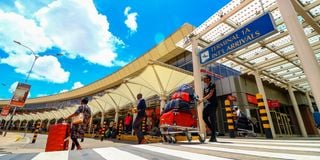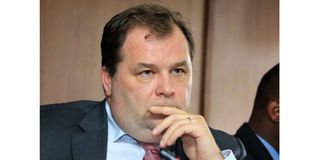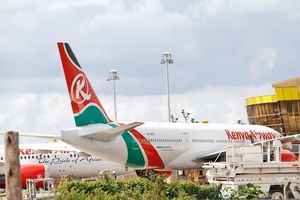
Passengers exit with their luggage at the International Arrival Terminal 1A at Jomo Kenyatta International Airport on November 7, 2023.
On February 26, 2019, Mr Sebastian Mikosz, the Polish expatriate headhunted to turn around Kenya Airways, appeared before MPs to defend a Jomo Kenya International Airport (JKIA) takeover deal that had sparked public outrage.
The KQ chief executive officer told members of the National Assembly’s Transport committee that the struggling national carrier had to control JKIA if it was to turn around its fortunes.
Under the 30-year concession plan, Kenya Airways was to, through a special purpose vehicle, manage and develop JKIA at a fee. Based on KQ’s financing model, the annual concession fee had been set at $28 million (about Sh2.9 billion) rising gradually over the years to peak at $60 million (about Sh6.1 billion) in 2033.
That meant Kenya Airports Authority (KAA) was to surrender an asset that generated 83 percent of its revenue to a loss-making entity, and only focus on low-yield airstrips scattered across the country, a proposition that wasn’t agreeable to a parliamentary watchdog.
In a separate probe, the Public Investment Committee (PIC) questioned the logic and motive of transferring the management of JKIA from a profit-making KAA to a loss-making KQ, which as of February 2019 owed KAA Sh3.8 billion.
However, according to Sebastian, KQ which was in the red could not become competitive if it did not make money by running JKIA as other successful airlines in the continent.
“In our analysis, we have given examples of Ethiopian Airlines, and Rwandair, the main Gulf Carriers are Emirates and Qatar as well as Turkish Airlines. All these are organised in the manner that we are proposing in this document. All the airlines that are struggling such as the South African airline and Air Mauritius are working with a model that we currently do,” Sebastian told MPs.
Public Private Partnership
The proposal they had on the table was a Public Private Partnership (PPP) structure in which case the private entity would be KQ.
KAA, he disclosed, had since submitted KQ’s proposal to the PPP committee which is part of Treasury.
“The whole purpose of doing a PPP which has unfortunately elicited a lot of emotional reaction is not to merge or to buy JKIA, but is to have a concession operator agreement,” Sebastian insisted.
“This means that the buildings and all the land will remain owned by KAA and ultimately owned by the government. The word merger or acquisition is not applicable. It is a system where we want to create holding where all the assets can finance each other and are aligned for growth,” he explained.
The deal they were proposing, he went on, “is that the Kenyan Government puts together all the assets together so that we all work together towards one direction, and not compete.”

Kenya Airways Group MD and CEO Sebastian Mikosz before the National Assembly Transport, Public Works and Housing Committee on November 29, 2018.
“Only when the PPP committee approves can we go into negotiation with KAA,” he added. But he defended the plan as “a result of a quite long-lasting process of thinking of making Nairobi and KQ remain in Africa’s top three hubs in the coming years.”
They had arrived at the plan they considered the magic bullet to halt the loss of KQ’s market share to competition after finding that “our biggest competitors which are African and Gulf Carriers are structured in a way that all their assets contribute towards growing the GDP of their countries, grow their connectivity, jobs creation and they have a different mandate.”
“While discussing this among management but also with the sub-committee in government that was helping us in finding a way forward, we decided to copy what the competition was doing already. It is with this that KQ decided to approach its proposal as a PPP,” Sebastian concluded.
Once implemented, he observed, the arrangement would grow JKIA to be the main central hub which would attract more carriers and support KQ’s growth strategy.
Sebastian told the MPs they had the entire plan all figured out from the financing of the proposed operations, the experience of the team to run the operations, and the employment or redundancy plan.
Curiously, on the same day Sebastian was pitching the plan to members of the Transport Committee, another House watchdog, the Public Investment Committee (PIC), was tabling a hostile report against the proposed takeover of JKIA operations by Kenya Airways.
PIC also cited a conflict of interest given the chairperson of KAA which was driving the deal was also the chair of a bank that was a shareholder in Kenya Airways.
Obvious risks
“The proposed takeover is being rushed despite obvious risks associated with it including concerns on its financial viability and the potential loss of jobs at KAA. The Authority had allegedly been given a mid-December 2018 timeline to complete the transaction as per Board minutes,” stated the report by PIC chaired by Abdullswamad Nassir, now Mombasa governor.
“There is a potential conflict of interest in the proposed takeover where the chairperson of the KAA board also chairs a bank that is a shareholder in Kenya Airways, the entity that proposes to take over the airport. The chair of the KAA Board acknowledged this during the Board’s 296th sitting stating that he is the chairman of a bank that is a big shareholder in KQ. He however stated that he would put this conflict aside and focus on KAA,” the report noted.
The bank in question was the Kenyatta family-linked- NCBA.
PIC noted the JKIA takeover by KQ had been initiated by President Uhuru Kenyatta’s Cabinet and communicated to KAA on May 29, 2018, by the Transport principal secretary. “The said resolution from KQ has neither been seen by the KAA nor the committee,” the PIC report stated.
PIC recommended the controversial deal be halted. It collapsed following rising public uproar, just as is the case with the recently reported deal.









